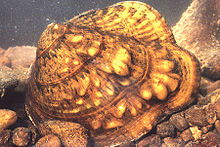
A pearl is a hard, glistening object produced within the soft tissue of a living shelled mollusk or another animal, such as fossil conulariids. Just like the shell of a mollusk, a pearl is composed of calcium carbonate in minute crystalline form, which has deposited in concentric layers. The ideal pearl is perfectly round and smooth, but many other shapes, known as baroque pearls, can occur. The finest quality of natural pearls have been highly valued as gemstones and objects of beauty for many centuries. Because of this, pearl has become a metaphor for something rare, fine, admirable and valuable.

Mussel is the common name used for members of several families of bivalve molluscs, from saltwater and freshwater habitats. These groups have in common a shell whose outline is elongated and asymmetrical compared with other edible clams, which are often more or less rounded or oval.

Lake Powell is an artificial reservoir on the Colorado River in Utah and Arizona, United States. It is a major vacation spot visited by approximately two million people every year. It is the second largest artificial reservoir by maximum water capacity in the United States behind Lake Mead, storing 25,166,000 acre-feet (3.1042×1010 m3) of water when full. However, Lake Mead has fallen below Lake Powell in size several times during the 21st century in terms of volume of water, depth and surface area.

The zebra mussel is a small freshwater mussel. The species was originally native to the lakes of southern Russia and Ukraine, but has been accidentally introduced to numerous other areas and has become an invasive species in many countries worldwide. Since the 1980s, the species has invaded the Great Lakes, Hudson River, and Lake Travis.

The blue mussel, also known as the common mussel, is a medium-sized edible marine bivalve mollusc in the family Mytilidae, the mussels. Blue mussels are subject to commercial use and intensive aquaculture. A species with a large range, empty shells are commonly found on beaches around the world.

The Anacostia River is a river in the Mid Atlantic region of the United States. It flows from Prince George's County in Maryland into Washington, D.C., where it joins with the Washington Channel to empty into the Potomac River at Buzzard Point. It is approximately 8.7 miles (14.0 km) long. The name "Anacostia" derives from the area's early history as Nacotchtank, a settlement of Necostan or Anacostan Native Americans on the banks of the Anacostia River.
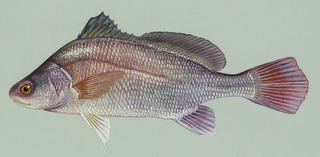
The freshwater drum, Aplodinotus grunniens, is a fish endemic to North and Central America. It is the only species in the genus Aplodinotus, and is a member of the family Sciaenidae. It is the only North American member of the group that inhabits freshwater for its entire life. Its generic name, Aplodinotus, comes from Greek meaning "single back", and the specific epithet, grunniens, comes from a Latin word meaning "grunting". It is given to it because of the grunting noise that mature males make. This noise comes from a special set of muscles within the body cavity that vibrate against the swim bladder. The purpose of the grunting is unknown, but due to it being present in only mature males and during the spawning season, it is assumed to be linked to spawning.
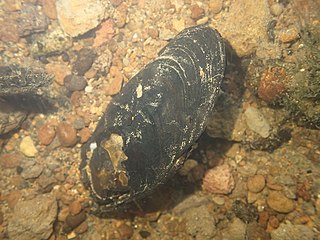
Echyridella menziesii, the New Zealand freshwater mussel, also known by its Māori names kākahi, kāeo, and torewai, is a species of freshwater mussel endemic to New Zealand. E. menziesii is an aquatic bivalve mollusc in the family Unionidae, the river mussels.

The Unionidae are a family of freshwater mussels, the largest in the order Unionida, the bivalve molluscs sometimes known as river mussels, or simply as unionids.

The freshwater pearl mussel is an endangered species of freshwater mussel, an aquatic bivalve mollusc in the family Margaritiferidae.

Unionida is a monophyletic order of freshwater mussels, aquatic bivalve molluscs. The order includes most of the larger freshwater mussels, including the freshwater pearl mussels. The most common families are the Unionidae and the Margaritiferidae. All have in common a larval stage that is temporarily parasitic on fish, nacreous shells, high in organic matter, that may crack upon drying out, and siphons too short to permit the animal to live deeply buried in sediment.
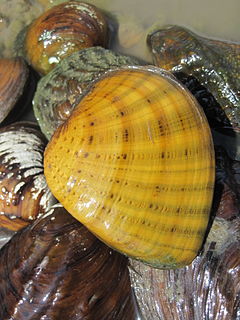
Ellipsaria lineolata is a species of freshwater mussel, an aquatic bivalve mollusk in the family Unionidae, the river mussels. This is the sole species in the monotypic genus Ellipsaria . This species is native to the drainage systems of the Mississippi River, the Mobile River, the Tennessee River, and the Cumberland River in the United States. It exists in the midwestern United States, and has also been observed in the east coast and as far south as the Gulf of Mexico. The common name of Ellipsaria lineolata is the Butterfly Mussel.

The oyster mussel is a rare species of freshwater mussel in the family Unionidae. This aquatic bivalve mollusk is native to the Cumberland and Tennessee River systems of Kentucky, Tennessee, Alabama, and Virginia in the United States. It has been extirpated from the states of Georgia and North Carolina. It is a federally listed endangered species of the United States.

Plethobasus cooperianus, the orange-footed pimpleback mussel or orangefoot pimpleback, is a rare species of freshwater mussel in the family Unionidae, the river mussels. This aquatic bivalve mollusk is native to the Tennessee, Cumberland, and lower Ohio Rivers in the United States, where its distribution has declined over 70%.
Freshwater bivalves are one kind of freshwater mollusc, along with freshwater snails. They are bivalves which live in freshwater, as opposed to saltwater, the main habitat type for bivalves.

Freshwater molluscs are those members of the Phylum Mollusca which live in freshwater habitats, both lotic such as rivers, streams, canals, springs, and cave streams and lentic such as lakes, ponds, and ditches.
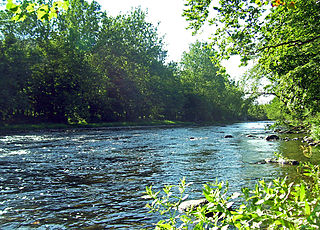
The Neversink Preserve is located in Deerpark, Orange County, New York. It was created in 1993 by The Nature Conservancy. They purchased 170 acres (69 ha) of land on the Neversink River and created the Neversink Preserve in order to protect the newly discovered and federally endangered species of mussel, the dwarf wedge mussel. Over time they have purchased more land so that the Neversink Preserve covers 550 acres (220 ha). Theodore Gordon, considered the father of modern American fly-fishing, perfected his dry-fly techniques here in the 19th century. Nearly 15 million people rely on the waters of the Delaware River Basin for drinking water and industrial use, making the Neversink Preserve a top priority of The Nature Conservancy.

Stuffed mussels or Midye is a generic name for plump orange mussels that contain herbed and spiced rice. Midye dolma is a popular and common street food snack in the coastal cities of Turkey.

Theliderma tuberosa, the rough rockshell, is a species of freshwater mussel. It is an aquatic bivalve mollusk in the family Unionidae, the river mussels. It has sometimes been treated as a variety or big-river ecotype of Theliderma metanevra, due to only having slight shell differences.
